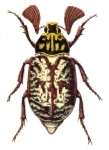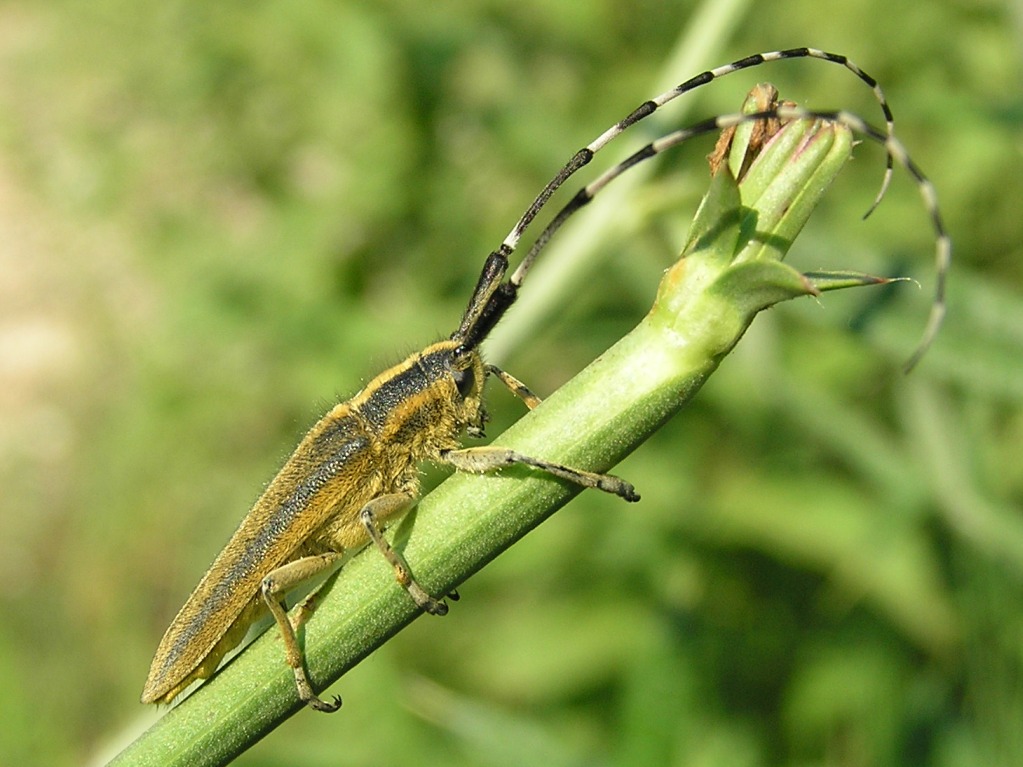|
Description / Habitats / Flora / Vertebrates / Insects / Invertebrates / What's that Bug? Home / Nestos Delta / Bibliography / About this site / Links / Contents / Galleries ____________________________________________________________________________ |
|
__________________________________________________________________________________________________________ THE LONGHORN BEETLES (COL., CERAMBYCIDAE) OF THÁSOS Longhorn beetles are distinctive insects and many species are both brightly coloured and conspicuous when they visit flowers for food, as such they are amongst the relatively few beetle families that draw attention from the casual observer. On Thásos perhaps the most obvious species is Agapanthia cyanarae, a large beetle with long black-and-white ringed antennae that breeds in thistle stems and the adults can be seen at flowers in early summer. Members of the sub-family Lepturinae are often abundant in flower-rich grassland in May and June, including the spectacular red and black Stictoleptura cordigera, but many longhorn species are inconspicuous and easily overlooked.
Migliaccio et al. (2007) report that 255 species of cerambycid have been confirmed from neighbouring Bulgaria, but only 177 taxa are listed by Oertzen (1886) for Greece. The Greek total will have extended considerably since then, particularly with the numerous field and taxonomic investigations carried out in recent decades by Gianfranco Sama from Italy and Milan Sláma from Czechia. Strangely, Karnozickij (1959) has no records for this family of beetles on Thásos during the studies carried out by Bulgarian entomologists on the island in the 1940s. In fact, the only previous published records I have come across are those of Markalas (1991) who recorded three species in his research on the saproxylic fauna of burnt pine trees on Thásos: Acanthocinus griseus, Arhopalus ferus and Pogonochaerus perroudi. Lance Chilton sent me photographs of Morimus funereus encountered on the slopes of Ipsarion at Panagia in 2008, but the other 26 species currently known from the island have been recorded during my own fieldwork between 1993 and 2016 (marked with an asterisk in the Checklist below). The list includes Obrium cantharinum, which Dascălu et al. (2012) claim as New to Greece on the basis of a specimen captured in May 2007 at Lake Kerkini: records from Thásos at Panagia in 1999 and Limenas in 2003 pre-date this observation.
The most commonly encountered species of lowland situations, such as Pseudovadonia livida, Stenopterus rufus, Stenurella bifasciata, S. septempunctata and Stictoleptura cordigera, are likely to have been recorded already but there is plenty of scope for discovery in the extensive upland woodlands and grasslands. There will undoubtedly be many more species to add to the island's longhorn fauna as the group has not been specifically sought for during my fieldwork. Amongst the more interesting species found so far are Cerambyx welensii, which inhabits the ancient sweet chestnuts Castanea sativa behind Panagia, and Morimus funereus in woodland higher up the slopes. The latter is currently classified as Vulnerable by the IUCN, and is included on Annex II of the EU Habitats Directive, but genetic studies (Solano et al. 2013) have shown that it is almost certainly a sub-species of the widespread and very variable Morimus asper. Cerambyx welensii is considered to be Near Threatened in Europe (Nieto & Alexander 2010) and is further evidence of the significance of the small cluster of ancient sweet chestnuts at Panagia. The trees line a gravel track used heavily by lorries from the marble quarries and it would be sensible to formally recognise their importance for saproxylic organisms.
I am grateful to Paul Whitehead for help with identification and to Lance Chilton for his record of Morimus funereus from Thásos.
CHECKLIST Prioninae Ergates faber (Linnaeus, 1761) * Spondylidinae Arhopalus ferus (Mulsant, 1839) Lepturinae
Alosterna (Alosterna)
tabacicolor (De Geer, 1775) * Cerambycinae
Cerambyx welensii (Küster,
1846) * Lamiinae Acanthocinus (Acanthocinus)
griseus (Fabricius, 1792) REFERENCES
Dascălu, M.M., Sama, G. & Ramel, G. 2012. A report on the Cerambycidae species from the Lake Kerkini National Park, northern Greece. Analele Științifice ale Universității Alexandru Ioan Cuza din Iași, s. Biologie animală, LVIII: 65-76. Georgiev, G.T. & Stojanova, A. 2003. New and rare Longhorn Beetles (Coleoptera: Cerambycidae) in the Strandzha Mountain, Bulgaria. Acta Zoologica Bulgarica, 55: 105-109. Karnozickij, N. 1959. Materialien zur Koleopteren-Fauna der Agäischen Küste und Insel Thasos. Izv. zool. Inst. Sof., 8: 237-253. Markalas, S. 1991. Insects attacking burnt pine trees (Pinus halepensis, P. brutia and P. nigra) in Greece. Anzeiger Fur Schadlingskunde Pflanzenschutz Umweltschutz, 64: 72-75. Migliaccio, E., Georgiev, G. & Gashtarov, V. 2007. An annotated list of Bulgarian Cerambycids with special view on the rarest species and endemics (Coleoptera: Cerambycidae). Lambillionea, 107 (supplement 1): 1–78. Nieto, A. & Alexander, K.N.A. 2010. European Red List of Saproxylic Beetles. Luxembourg, Publications Office of the European Union. Oertzen, E. v. 1886. Verzeichniss der Coleopteren Griechenlands und Cretas. Berliner Entomolog. Zeitschrift, 30: 189-293. Sláma, M. & Slamova, J. 1996. Contribution to the recognition of Greek and Yugoslavian Longicorn Beetles (Coleoptera, Cerambycidae). Biocosme Mésogéen, Nice, 12: 117-143. Solano, E., Mancini, E., Ciucci, P., Mason, F., Audisio, P. & Antonini, G. 2013. The EU protected taxon Morimus funereus Mulsant, 1862 (Coleoptera: Cerambycidae) and its western Palaearctic allies: systematics and conservation outcomes. Conservation Genetics, 14: 683–694.
|

















